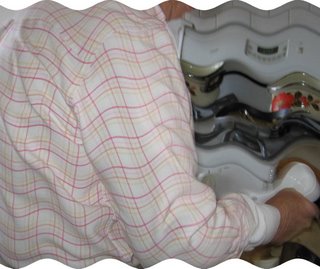A nun from a faraway time told this story to my grade-school class.
There was a farmer with a son whose sins had grown in number and in severity. The farmer's barn was new and like many in the neighborhood had vertical boards painted a nice bright red. Everyone agreed the barn was beautiful.
One day the son committed another transgression (you know, the serious kind where your son almost gets killed--and not in an accident!). The father had been unsuccessful in the past using verbal chastisement, spankings, and loss of privileges. The boy usually returned to his devilish ways within a day or two. Discipline seemed to have no effect.
After much prayer and thought, the father decided on another approach. Within a 24-hour period, a doll was badly damaged when the boy pulled the doll from his little sister. As the father finished calling his son to account for his meanness, he gave the boy a new punishment.
The boy was handed a hammer and told to drive a large nail into the barn door, leaving half the nail sticking out. Over the next few months , a large number of crooked, rusty nails had accumulated in the barn door and were a constant reminder to everyone of the boy's transgressions. The boy was embarrassed because his many sins were publicly represented on the barn door.
People can and do change, and the boy began to become a better boy. When he told his father he was sorry for having hurt the dog, his father forgave him and said he could pull out one of the nails in the barn door. The boy learned how to admit his past mistakes and sins, and each time he was sincerely sorry, his father forgave him and more nails came out of the barn door.
Finally the father, in loving words, told the boy all his transgressions were forgiven and he could remove the remaining nails. The boy used his hammer claw to pry loose the last two nails, but seemed unhappy. He explained to his father that even though all of the nails were gone, the door had ugly scars--the nail holes.
The father took the boy to the tool shed where he found a small sealed can. He explained to his son that the can had red wood filler to seal the nail holes. The boy was about ready to start sealing all the nail holes, but the father stopped his son. "Son, the damage that is done by sin cannot be repaired so quickly. Even though I forgive you, the damage of your sins is still there. Each time you do a good thing, you can seal one nail hole." The boy learned how to pray, practice virtues, chastise himself, and help others, and the nail holes finally disappeared.
The nun who told us that story used it as an illustration of the temporal punishment of sin. God forgives sin, but there is temporal punishment that remains to be satisfied. The Baltimore Catechism has three relevant questions:
Q. 629. What punishments are due to actual sins? A. Two punishments are due to actual sins: one, called the eternal, is inflicted in hell; and the other, called the temporal, is inflicted in this world or in purgatory. The Sacrament of Penance remits or frees us from the eternal punishment and generally only from part of the temporal. Prayer, good works and indulgences in this world and the sufferings of purgatory in the next remit the remainder of the temporal punishment.
Q. 804. Why does God require a temporal punishment as a satisfaction for sin? A. God requires a temporal punishment as a satisfaction for sin to teach us the great evil of sin and to prevent us from falling again.
Q. 805. Which are the chief means by which we satisfy God for the temporal punishment due to sin? A. The chief means by which we satisfy God for the temporal punishment due to sin are: Prayer, Fasting, Almsgiving; all spiritual and corporal works of mercy, and the patient suffering of the ills of life.
Subscribe to:
Post Comments (Atom)









No comments:
Post a Comment